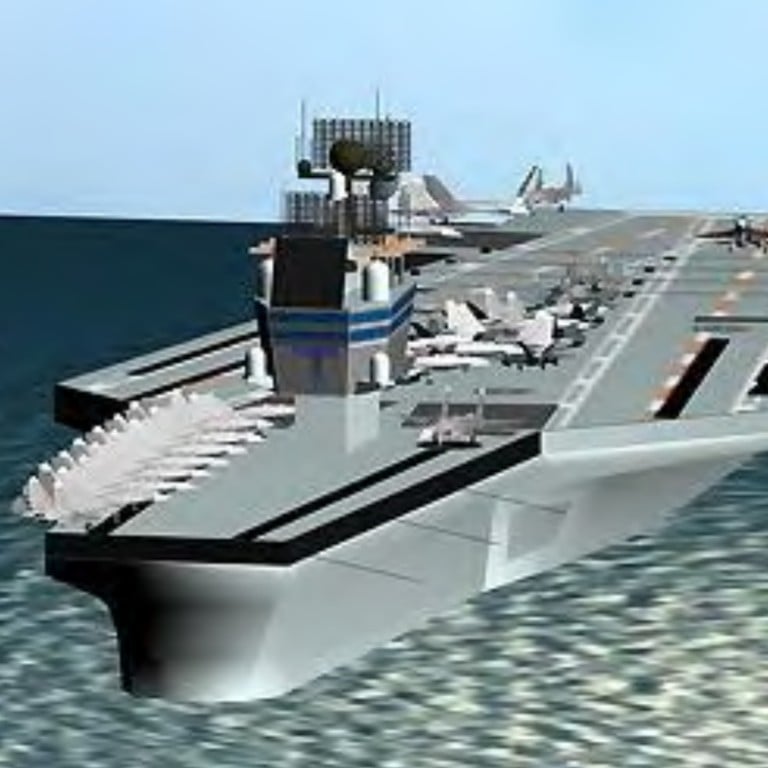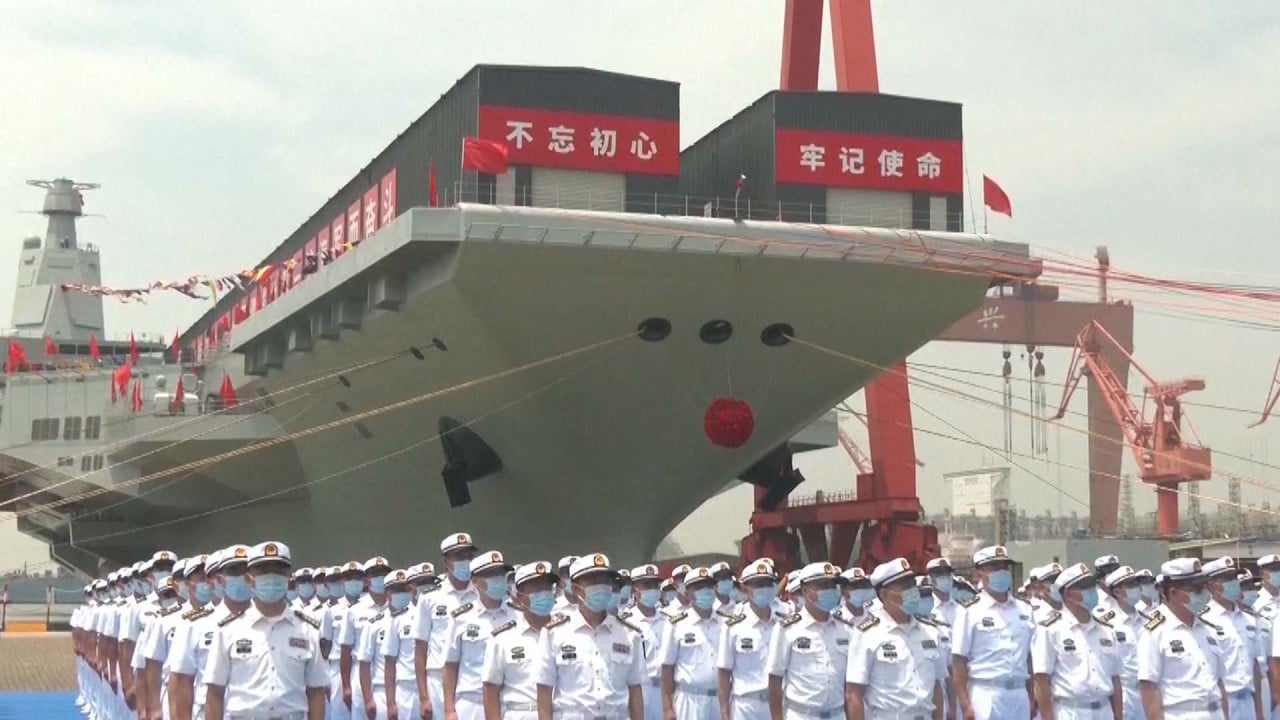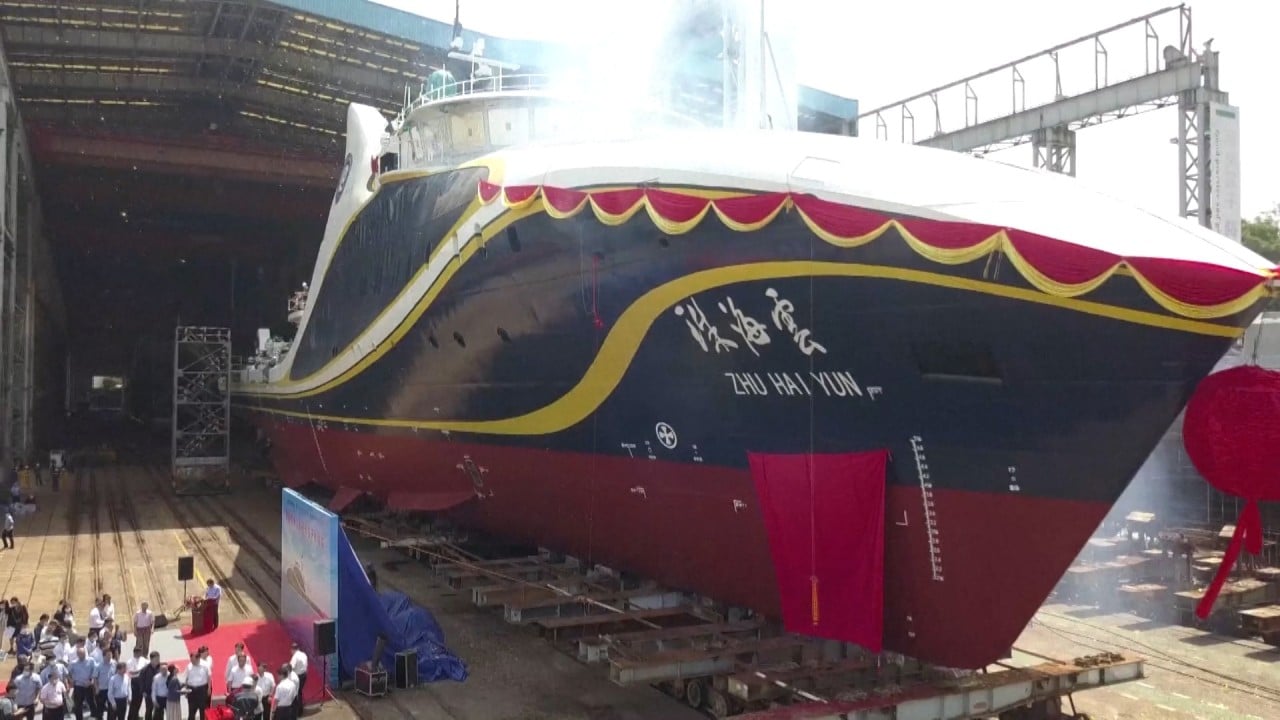
China’s top naval scientist proposes a Star Wars-style ‘supership’ to convert nuclear energy to kinetic force weapons
- Breakthroughs in electromagnetic launch technology pave the way for a nuclear-powered warship to carry rail gun, laser and high-powered microwave: Ma Weiming
- Researchers do not say when the supership will be built, but say China is ready to take the idea from science fiction to the real world
“It will completely overturn the combat formation of naval fleets that has been in place for over a hundred years,” he said in a peer-reviewed paper published in Transactions of China Electrotechnical Society journal on June 13.
China’s so-called supership could do the job of almost an entire carrier fleet, Ma and his colleagues said in the paper while describing a new naval combat system that brings together electromagnetic weapons and a powerful nuclear-powered electrical system.
According to a computer generated photo in Ma’s paper, the warship carries a large number of aircraft but differs from a traditional carrier.
While many aircraft carriers are nuclear-powered, their electrical systems are typically designed to power the ship’s propulsion and other basic systems. Their primary role is to provide air support for naval operations, rather than engaging in direct combat.
The super warship is armed with new electromagnetic weapons such as rail guns, coilguns, rocket launchers, laser weapons and high-powered microwaves.
The ship’s advanced technology “cleverly and effectively transform the energy from the ship’s power source into the electromagnetic energy needed to power high-powered weapons,” according to the paper.
This could give a single warship the ability to accurately defend against air attacks, engage in anti-submarine warfare, intercept missiles and deliver precise strikes on both naval and land targets.
“As a result, a single all-purpose ship can perform the traditional tasks of a fleet of conventional ships,” Ma said.
At present, nuclear energy cannot be used as a weapon in conventional warfare.
EU cuts Chinese firms from sanctions list over flow of military goods to Russia
The supership’s comprehensive nuclear-powered electromagnetic system could convert nuclear energy into usable kinetic energy or electricity to drive high-energy weapons systems, Ma’s team said.
The paper said the electromagnetic rail guns on board, for instance, had a long reach and could hit targets in near space with guided ordnance at up to seven times the speed of sound.
The electromagnetic-launched missiles could be automatically reloaded like an automatic rifle and allowed far greater speed and number of missiles to be fired than those of adversaries, the researchers said.
And the electromagnetic coilguns could launch different types of underwater weapons, significantly enhancing the ship’s capabilities for underwater attacks and defence.
Laser weapons use the speed of light to transmit energy, allowing for extremely accurate targeting. On the other hand, high-powered microwave weapons have a broad impact area and are effective in countering multiple targets simultaneously.
Thanks to the nearly endless supply of nuclear energy and advanced power management system, the supership will also be equipped with powerful radars and other power-hungry sensors to detect the enemy from a greater distance than ever before, according to the paper.
Ma’s team did not estimate when the supership would be built, but it said China was ready to take the idea from science fiction to the real world.
In the paper, the naval researchers listed recent breakthroughs in China that would pave the way for the ship’s construction. Some were declassified for the first time.
The Chinese navy, for instance, has developed and implemented an electromagnetic launch system for weapon payloads on various types of combat platforms, including vehicles, ships, and submarines, according to Ma.
“At present, China has solved all the key technologies of the electromagnetic launch system for weapon payloads on various types of combat platforms, including vehicle-mounted, shipborne and underwater systems,” he said in the paper.
The electric launch missile system is a type of system that uses electromagnetic energy to launch missiles.
One of the main advantages of the electric launch missile system is that it allows for rapid and repeated firing of missiles. Unlike traditional missile launch systems, which typically require a significant amount of time to reload and prepare for firing, the electric launch missile system can be automatically reloaded, allowing for rapid and sustained firing of missiles.
If a traditional aircraft carrier fleet is approaching the supership with the intention of launching a coordinated attack, the supership could respond by using its electric missile launch system to launch a barrage of missiles at the carrier fleet.
The speed and accuracy of the electric missile launch system would make it difficult for the carrier fleet to evade or defend against the incoming missiles.
The advantage of the electric missile launch system over a traditional missile launch system is similar to the advantage of an automatic rifle over a single-shot rifle, allowing for more rapid and effective engagement of targets, which could decide the outcome of a naval battle.
China is so far the only country that has carried out firing experiments of a large rail gun at sea. The Naval University of Engineering in China has recently achieved several significant breakthroughs in the development of smaller electromagnetic guns, according to Ma.
These advancements include making the launch device and power supply lighter, integrating the electromagnetic gun weapon system into vehicles, and using projectile matching and electromagnetic spin-up technology to enhance shooting accuracy.
“Long-range field tests with [the] bullet exit kinetic energy of tens of kilojoules have been completed, which broke the range and kinetic energy record of current firearms in the world,” said Ma.
A typical 9mm handgun bullet has a muzzle energy of around 500 joules. This means that the electromagnetic gun developed by China has at least 100 times or so more killing energy than a typical 9mm handgun.
China is also currently developing electromagnetic coil launch technology that can launch a projectile at up to 1,000 metres (3,280 feet) per second, or more than three times the speed of sound, according to the paper.
US Navy’s ‘Lightning carrier concept’ has lessons for China’s military
Coilguns use a series of electromagnetic coils to accelerate the projectile, while rail guns use parallel rails to create a magnetic field that propels the projectile. This difference in design makes coilguns easier to build and maintain.
Ma said the application of electromagnetic launch technology in the Chinese navy in recent years was the result of more than two decades of hard work and intense competition with rivals in the West.
“The United States had … been a leader in this field since the 1980s,” he said. But from the turn of the millennium, Chinese scientists have received more persistent support from their government than their competitors.
The CG(X) project, for instance, was a US Navy programme to develop a new class of guided missile cruisers, which would have been equipped with advanced weapons systems, including electromagnetic launch systems.
The programme was cancelled in 2010 because of “technological requirements that were too high and costs that were too high”, Ma said.
The US Navy’s rail gun programme was another project to develop a high-powered rail gun for use in future warfare. However, the programme has faced technical challenges related to power supply and heat dissipation, and has been scaled back in recent years.
The US has faced some challenges in developing electromagnetic launch systems, and has had to scale back or cancel some projects because of technical challenges and budget constraints.
This has slowed US progress in this area, and has given China an opportunity to gain an advantage in the race to develop more advanced and effective electromagnetic launch systems.
The Chinese navy, for example, has developed pulse energy storage modules that can store hundreds of kilojoules of energy and can be combined in a modular building block fashion to achieve total energy storage in the hundreds of megajoules, according to Ma.
This represents a significant breakthrough in the development of high-capacity pulse energy storage systems for electromagnetic launch applications, with performance several times higher than similar systems used by the US Navy.
China has also developed a GNC (guidance, navigation and control) module with high overload resistance for use in electromagnetic launch systems, Ma said.
This module is designed to provide accurate guidance and control of the projectile during launch, even in high-overload scenarios where the projectile is subjected to extreme forces up to 35,000 times the force of gravity.
A guided rail gun projectile can actively steer itself towards the intended target, compensating for factors such as wind, gravity or target movement.
This improves the chances of hitting the target accurately, especially over long distances.
Is Japan eyeing troop presence in Manila to back Taiwan amid China tensions?
The mass application of electromagnetic launch technology will encounter many challenges. China’s naval university established an electromagnetic launch engineering major as early as 2017.
The goal is to cultivate talent engaged in the design, production supervision and lifelong operation and maintenance management of electromagnetic launch equipment, according to Ma.
“This was a big step forward for electromagnetic energy equipment. It has moved from being just a theoretical concept to becoming a practical engineering reality,” he added.




